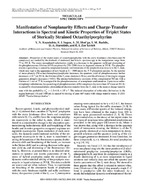Manifestation of nonplanarity effects and charge-transfer interactions in spectral and kinetic properties of triplet states of sterically strained octaethylporphyrins

Authors
Date
2001Bibliographic entry
Manifestation of nonplanarity effects and charge-transfer interactions in spectral and kinetic properties of triplet states of sterically strained octaethylporphyrins / V. N. Knyukshto [et al.] // Optics and Spectroscopy. – 2001. – Vol. 90, № 1. – P. 67-77.
Abstract
Properties of the triplet states of octaethylporphyrins with the steric hindrance (free bases and Pd complexes) are studied by the methods of stationary and kinetic spectroscopy in the temperature range from 77 to 293 K. The mono-mesophenyl substitution results in a decrease in the quantum yield and shortening of the phosphorescence lifetime of Pd complexes by 250–3500 times in degassed toluene at 293 K. The phosphorescence quenching is caused by nonplanar dynamic conformations of the porphyrin macrocycle in the T₁ state, which also lead to the appearance of new bands at λ ~ 1000 nm in the T—T absorption spectra. As the number of meso-phenyls (Pd-octaetyltetraphenylporphyrin) increases, the quantum yield of phosphorescence further decreases (<10⁻⁵) at 293 K, the lifetime of the T₁ state shortens (<50 ns), and the efficiency of the singlet oxygen generation abruptly decreases (<0.01). The intense bathochromic emission of this compound at 705 nm with a lifetime of 1 ms at 77 K is assigned to the phosphorescence of a nonplanar conformation. Upon meso-orthonitrophenyl substitution, the quenching of phosphorescence of Pd complexes (by more than 10⁴ times at 293 K) is caused by direct nonadiabatic photoinduced electron transfer from the T₁ state to the nearest charge-transfer state with the probability k_et^T = (1.5-4.0) × 10⁶ s⁻¹. The induced absorption of ortho-nitro derivatives in the region between 110 and 1400 nm is caused by mixing of pure ππ⃰ states with charge-transfer states. © 2001 MAIK “Nauka/Interperiodica”.
